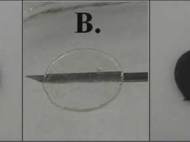Novel Ionic Liquid batteries demonstrated by NRL scientists
 Scientists at the Naval Research Laboratory (NRL) Materials Science and Technology Division are developing novel, lightweight energy storage devices. Rather than depend on highly acidic electrolytes, ionic liquids are used to create a solid polymer electrolyte composed of an ionic liquid and polyvinyl alcohol, thus developing novel types of solid state batteries with discharge voltages ranging up to 1.8 volts.
Scientists at the Naval Research Laboratory (NRL) Materials Science and Technology Division are developing novel, lightweight energy storage devices. Rather than depend on highly acidic electrolytes, ionic liquids are used to create a solid polymer electrolyte composed of an ionic liquid and polyvinyl alcohol, thus developing novel types of solid state batteries with discharge voltages ranging up to 1.8 volts.
The unique properties of ionic liquids have fostered this explosive interest in battery applications. Ionic liquids are room temperature molten salts that possess many important characteristics, such as nearly no vapor pressure, non-flammability and lack of reactivity in various electrochemical or industrial applications.
“It is the high thermal and electrochemical stability of the ionic liquids which has fostered the growing interest in ionic liquids for use in various electrochemical processes”, said Dr. Thomas Sutto. “These new types of solid-state cells mimic standard alkaline cells, but without the need for caustic electrolytes.”
Limits imposed by using corrosive electrolytes often result in severe restrictions to standard battery geometry and the need for special corrosive-resistant battery containers. The use of reactive ionic liquids in non-aqueous cells replaces the more hazardous highly alkaline electrolytes such as manganese oxide (MgO) and zinc (Zn) found in traditional batteries.
This research emerged from standard corrosion studies of different metals in ionic liquids. While working with ionic liquids based on mineral acids, such as hydrogen sulphates, it was observed that Zn metal would react to form zinc sulphate. Since this is similar to that observed for the zinc anode in a standard alkaline cell, a series of experiments were then performed to determine how different metal oxides reacted in these types of ionic liquids.
Electrochemical experiments shown that these reactive ionic liquids can act as electrolyte in both solid state and liquid batteries, and they can also act as a reactive species in the cell’s electrochemical structure. By using a non-aqueous approach to primary and secondary power sources, batteries are designed using standard cathode and anode materials such as magnesium dioxide (MgO2), lead dioxide (PbO2) and silver oxide (AgO). The ionic liquid that is the main focus of this work is 1-ethyl-3-methylimidazolium hydrogen sulphate (EMIHSO4), however, other ionic liquids such as those based on the nitrate and dihydrogen phosphate anions (negatively charged ions) have also been found to work well in this type of a battery design.
The use of these electrolytes suggests the potential for new types of rechargeable systems, such as replacement electrolytes in nickel-metal hydride (NiMH) batteries, or even the standard lead-acid battery. Te researchers are currently developing such a rechargeable ionic liquid power source. The ability to create solid separators also allows for the formation of many new types of batteries via various fabrication techniques.









Good Innovation in Batteries.
Dr.A.Jagadeesh Nellore(AP),India